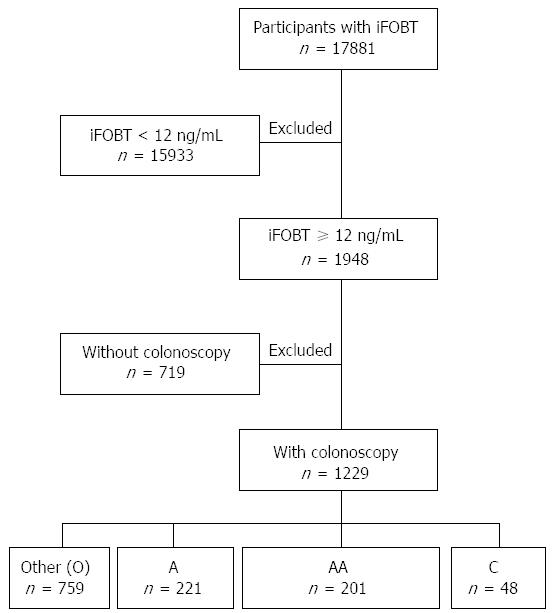Copyright
©2013 Baishideng Publishing Group Co.
World J Gastroenterol. Dec 7, 2013; 19(45): 8366-8372
Published online Dec 7, 2013. doi: 10.3748/wjg.v19.i45.8366
Published online Dec 7, 2013. doi: 10.3748/wjg.v19.i45.8366
Figure 1 Flowchart of study participants recruited from the two-step colorectal cancer screening program.
O: Other; A: Adenoma; AA: Advanced adenoma; C: Cancer.
Figure 2 Cancer stage difference between the colorectal cancer screening program and cancer registry database.
The cancer stage (X-axis) and proportion (Y-axis) of screening-detected cancers (CS) and the hospital cancer registry (CR) database. The stage migration was calculated as the difference in cancer proportions between the two databases (CS-CR).
Figure 3 Age, gender, and fecal immunochemical test concentration in association with histological grade of colorectal tumor.
A: Age; B: gender; C: FIT. The differences in age, gender, and FIT concentrations (Y-axis) in the different histological groups (X-axis). (Kruskal-Wallis test, all P < 0.001). FIT: fecal immunochemical test; O: Other; A: Adenoma; AA: Advanced adenoma; C: Cancer.
Figure 4 Fecal immunochemical test concentration in the prediction of colorectal neoplasia: linear regression analysis.
The association between FIT concentration with log(2) transformation (X-axis) and PPV (Y-axis). (all R2 > 0.95, P < 0.001). FIT: Fecal immunochemical test; O: Other; A: Adenoma; AA: Advanced adenoma; C: Cancer; PPV: Positive predictive value.
- Citation: Liao CS, Lin YM, Chang HC, Chen YH, Chong LW, Chen CH, Lin YS, Yang KC, Shih CH. Application of quantitative estimates of fecal hemoglobin concentration for risk prediction of colorectal neoplasia. World J Gastroenterol 2013; 19(45): 8366-8372
- URL: https://www.wjgnet.com/1007-9327/full/v19/i45/8366.htm
- DOI: https://dx.doi.org/10.3748/wjg.v19.i45.8366












